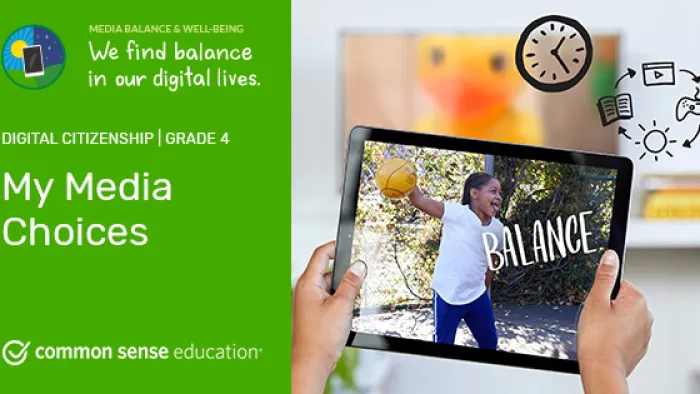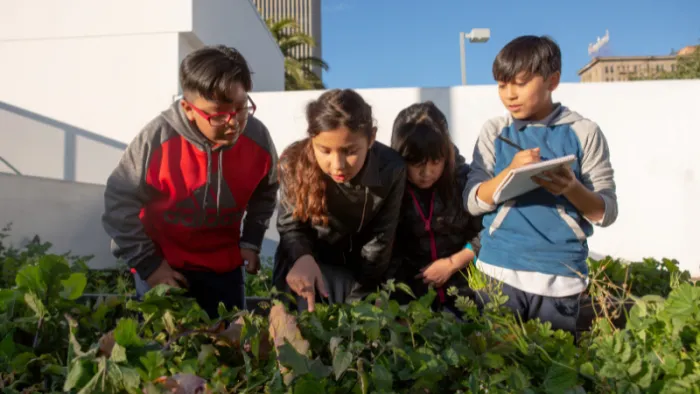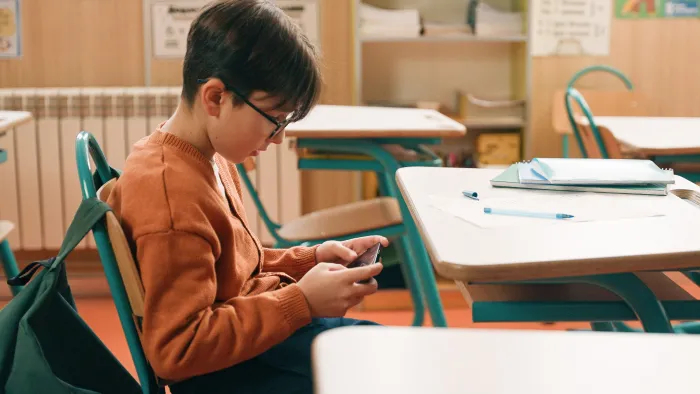Kids are on screens more than ever. How can we include media and tech with well-being in mind?
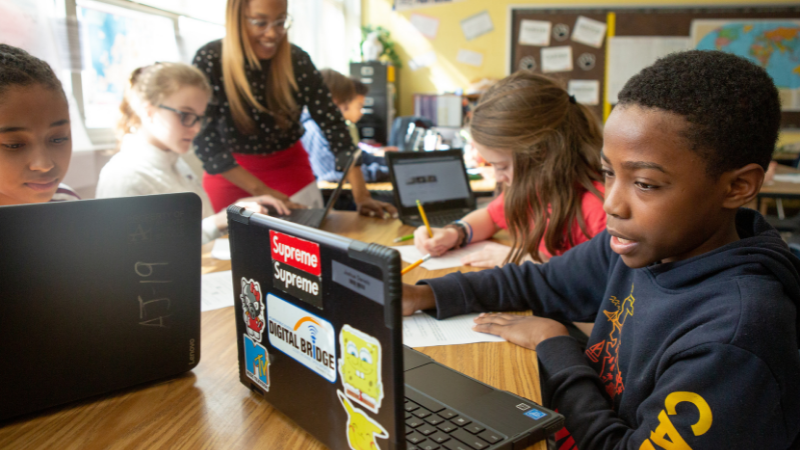
Screens are everywhere: at home, at school—even gas stations! But not all screen time is created equal. How much screen time we get doesn't account for other factors, like when, where, or most importantly what we're doing on the screen. Context matters, especially when it comes to classroom learning. Even with cellphone restrictions, the combination of screen use at school and at home is a concern to parents and caregivers, and screen use in school is sometimes considered unnecessary or harmful, no matter the context.
Addressing these concerns and finding the right balance for your students is important. While there's no single, correct formula for learning or to satisfy all concerns from caregivers, we want all technology use to be intentional, purposeful, and proportional.
We've outlined some important considerations to aid you in determining how to strike that balance, as well as linked resources for you, your students, and for families.
Be Purposeful About Screen Use
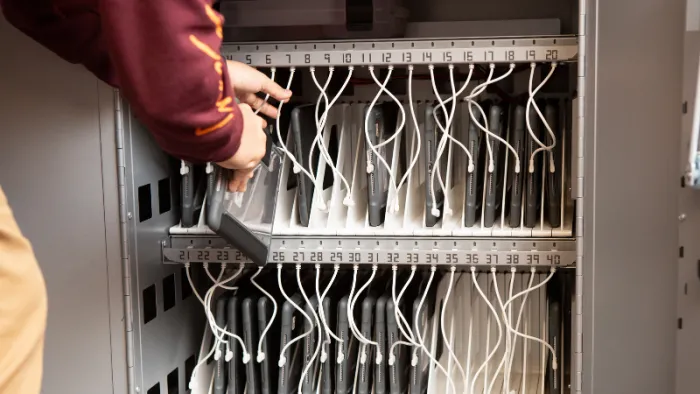
Naturally, how much digital media you use in the classroom—and how you use it—should depend a lot on the ages of your students, what you're teaching, and what the use of technology will add to the learning experience. Some topics like typing, coding, or computer science will obviously be more dependent on screens. Other activities like reading, for example, could sometimes be done on a screen, though that may not offer any benefits. Overall, it's essential to think about whether digital media and technology are enhancing students' learning, or potentially even detracting from it.
SAMR & the Selection Process
The why and how of tech integration are critical for positive outcomes. Sure, you can incorporate a digital tool, but does that mean it'll be effective for kids' learning? It's also important to note that there are tons of edtech tools out there, but they vary in efficacy, engagement, and impact on classroom culture. Choosing edtech is complex and should be a multi-tiered process that goes beyond impact studies and privacy features.
The SAMR model, developed by Dr. Ruben Puentedura, offers a framework you can use to think critically about how you're integrating digital media and technology in your classroom. SAMR stands for Substitution, Augmentation, Modification, and Redefinition. Our article on SAMR gives a deeper dive into this framework.
Dr. Tanner Higgin offers other questions to consider before adopting edtech tools that introduce additional considerations:
- What makes a tool fit into a specific classroom and get teachers and students excited to use it?
- Why do some "research-backed" tools suck the energy out of a room and get set aside?
- What does it mean when a tool increases academic outcomes but de-motivates students?
- What learning values and principles do different tools reflect and support? How do we know?
When considering all facets of how these tools impact students and learning, both at school and at home, we forge a clearer path forward when it comes to edtech.
Screens vs. Paper
In addition to clarifying why you're using a screen, it's also good to know if it will really improve learning outcomes. There may be times when using paper, perhaps to draw a model for a math problem, makes more sense than a screen. On the other hand, you might want to easily collect and record data, in which case a screen might make sense.
One common concern is text-based assignments: If you're offering students a text in a digital format, consider the context and ask yourself questions like:
- What kind of device and platform will students use to access the text?
- Are distractions just a click away?
- Does the platform have features to enhance students' comprehension?
- Does it have accessibility options for a range of learners?
You can also consider doing some of your own action research in your classroom: Compare your class's comprehension with print vs. digital texts. Poll your students to see what they prefer. Consider the reading experience of young people who often skim, scan, and toggle between screens all day.
And then, consider caregiver concerns about screen use at home: With the understanding the technology is nearly inescapable for a wide variety of tasks, is it also essential for learning outcomes and homework? If so, what reasoning and guidance can you offer parents and caregivers to address their concerns?
Accessibility & Differentiation
There are clearcut uses for tech when it comes to offering all students the same learning opportunities, no matter their abilities or skill levels. Teachers with access to technology tools in the classroom can—and should—take advantage of screens when they can help with differentiation and content accessibility for a range of learners. Google Classroom users, for instance, can take advantage of apps such as Read Along and Reading Mode. And plenty of other tools offer ways to assign individually for easier differentiation and translation. There are also plenty of device-based ways to make learning more accessible, including text-to-speech capabilities, font adjustments, keyboard use instead of handwriting, and more. So incorporating screens as a way to be more inclusive is a great reason to include them.
Defusing Distraction
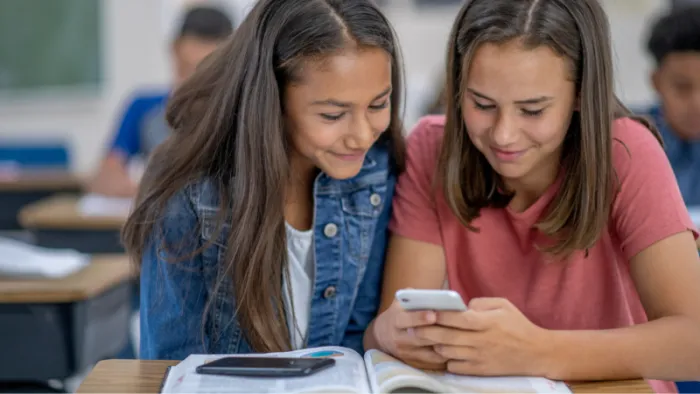
According to our research, kids are picking up their phones an average of 72 times each day (up to almost 500 times at the extreme end) and fielding a median of 237 notifications. When at school, kids use their phones a median of 43 minutes each day. A growing number of states and districts are implementing cellphone restrictions, which may reduce these distractions.
Students themselves report that they'd like to have clearer cellphone policies in schools. Whatever the cellphone policy is in your school or classroom, it's crucial that expectations are clear, consistent, and supported by all stakeholders. Here are some sample acceptable use policies (AUPs) to help you get started:
- San Ramon Valley Unified
- A Canva template
- A Common Sense Education Outreach presentation: Redo That AUP
But don't stop there: No matter your school's cellphone policy, it's also critical that students learn healthy habits around media and tech. Directly tying the reasoning around cellphone restrictions and your AUP to digital literacy and well-being gives students a better understanding about why it's so important to be deliberate about screens in school, which can reduce conflict and provide a concrete rationale the whole community can understand.
Informing Families About Screen Use at School
Parents and caregivers are a part of the school community, so it's also essential that they also understand the "why," "how," and "how much" about tech use in school. And to develop a strong rationale for tech use at school, it's necessary to incorporate the growing concerns around all kinds of screen use in classrooms into careful evaluation of how tech is applied to learning. The next step is communicating that rationale to parents and caregivers:
- Acceptable Use Policy: As discussed above, having clear expectations for all tech use in school lays a basic foundation. Though it has to cover a lot of ground in our tech-filled world, try to keep it as simple and easy to read as possible. Make sure it covers these topics:
- Cover cellphone use in classrooms and public spaces at specific times during the school day. Consider accommodations, school safety, and contingencies, as caregivers will ask about them.
- Cover AI use in class and for homework completion. Establish if there's a blanket policy of some kind and/or if teachers will address on an assignment basis.
- Anticipated Tech Use: With an AUP, students know what's expected of them, but caregivers also want to know what they can expect when it comes to tech.
- What devices will be issued? What services are in place for families without broadband?
- What software will be used in class and at home? Parents will likely ask about privacy and student data.
- Will all homework be completed on the device? How will this vary across grade bands? Caregivers of older students will likely expect more screen use than younger students.
- If a student needs a break from screens, will there be an alternative for work completion, when possible? Even though students may not choose this option, knowing kids can request a screen break may help calm concerns.
- Digital Literacy & Well-Being Instruction: Restrictions and rationales can only do so much. Teaching the life skills of digital literacy and well-being is a key piece to this puzzle. Involving caregivers in student learning around digital life skills closes the loop and reinforces healthy habits—and screen use balance—at home.
Resources and Tools for School and Home
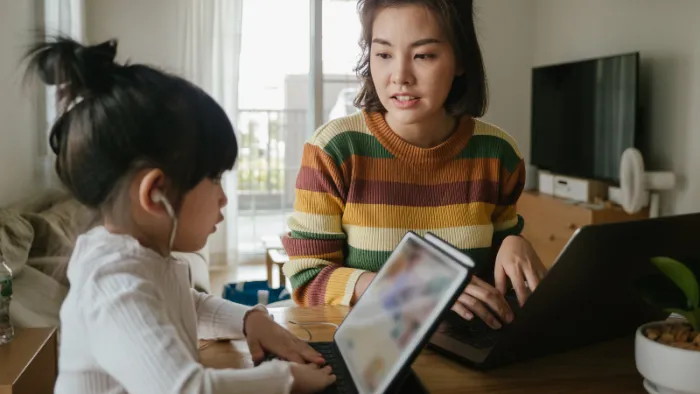
Resources for School
- Full Digital Literacy & Well-Being Curriculum: Helping kids develop the knowledge and skills they need to create and maintain healthy media and tech habits gives them agency around screen use and a common vocabulary for everyone to reference.
- Healthy Habits lessons: This topic and its lessons address media and tech balance specifically and round out the rationale for restrictions.
- Digital Learning Pledge for grades K–5 helps you set a positive culture of digital citizenship from the beginning of the year.
- Digital Learning Agreement for grades 6–12 helps you discuss expectations for online communication, privacy and safety, device use, and more.
- Devices for Learning: A Guide for Families: Customize and share this handy guide to make sure families have all of the information they need about any school-issued devices that students might bring home.
- Weekly newsletter: Every newsletter includes tips and resources you can share directly with families, covering everything from online safety tips to advice about managing kids' screen time and finding media balance at home.
Resources for Home
- Digital Literacy & Well-Being Family Tips and Activities: Striving for family engagement is always a goal, so share these tips, activities, tech planners, and more to help families find balance with screens at home.
- In-Person Learning Daily Routines: Caregivers can use this customizable schedule to outline daily learning schedules, give families important information, and check in with how students are feeling each day. Available in English and Spanish.
- Dinner Discussion: Help parents and caregivers stay informed about their students' progress with these helpful conversation starters. Available in English and Spanish.
- Kids and Tech: How Much Is Too Much?: This video (in English and Spanish) can help parents and caregivers with this essential screen-use question.
- When Families Ask About Healthy Digital Habits and Quality Content: These talking points and copy/paste tips can also help answer caregivers' questions about screen use.
Lead and second image courtesy of Allison Shelley/The Verbatim Agency for American Education: Images of Teachers and Students in Action.








